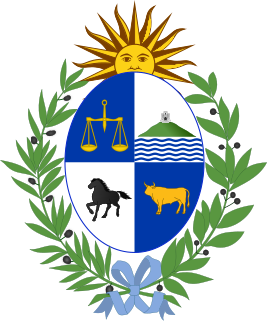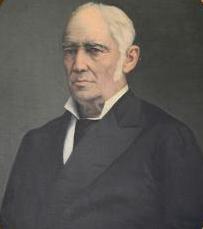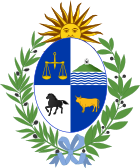The history of Uruguay comprises different periods: the pre-Columbian time or early history, the colonial period (1516–1811), the period of nation-building (1811–1830), and the history of Uruguay as an independent country.

The politics of Uruguay abide by a presidential representative democratic republic, under which the President of Uruguay is both the head of state and the head of government, as well as a multiform party system. The president exercises executive power and legislative power and is vested in the two chambers of the General Assembly of Uruguay. The Judiciary is independent from the executive and legislature.

José Casimiro Rondeau Pereyra was a general and politician in Argentina and Uruguay in the early 19th century.

The Chamber of Representatives is the lower house of the General Assembly of Uruguay. The Chamber has 99 members, elected for a five-year term by proportional representation with at least two members per department.

The General Assembly of Uruguay is the legislative branch of the government of Uruguay, and consists of two chambers: the Chamber of Senators and the Chamber of Representatives. General Assembly has 130 voting members: 99 representatives and 30 senators, the Vice President of the Republic, who serves as President of the General Assembly, and the Senate has the right to vote. The legislature meets in the Legislative Palace in Montevideo. Both senators and representatives are chosen through proportional representation for five-year terms.

The Constitution of Uruguay is the supreme law of Uruguay. Its first version was written in 1830 and its last amendment was made in 2004.

The Legislative Palace of Uruguay is a monumental building, meeting place of the General Assembly of Uruguay, and the seat of the legislative branch of the Uruguayan government. It is located in the barrio of Aguada in the city of Montevideo.
In the Treaty of Montevideo, signed on 27 August 1828, after British mediation, Brazil and Argentina recognized the independence of Uruguay.

Tres Cruces is a barrio of Montevideo, Uruguay. Its name means "three crossings", referring to the three major transportation routes which intersect in the area: Avenida 18 de Julio, Bulevar Artigas and Avenida 8 de Octubre. It is also the starting point of Italia Avenue.

The president of Uruguay, officially known as the president of the Oriental Republic of Uruguay, is the head of state and head of government of Uruguay. Their rights are determined in the Constitution of Uruguay. Conforms with the Secretariat of the Presidency, the Council of Ministers and the director of the Office of Planning and Budget, the executive branch. In case of absence, his office is exercised by the vice president. In turn, the president of the republic is the commander in chief of the Armed Forces.

Francisco Antonino Vidal (1827–1889) was born in Montevideo, though his birth has also been reported as in 1825, in San Carlos, Uruguay. He was a senator and two-time president of Uruguay.

Lauro Ayestarán was a Uruguayan musicologist.

Carlos María Domínguez is an Argentine writer and journalist who lives in Montevideo since 1989.
Fernando Octavio Assunção Formica was a Uruguayan historian, anthropologist, scholar, historian, and writer.
Events in the year 1871 in Uruguay.

The third Constitution of Uruguay was in force between 1934 and 1942.

Tomás Villalba y Albin was a Uruguayan politician who served as interim President for five days, at the end of the Uruguayan War, which had begun on 10 August 1864. The war was fought between the governing Blanco Party and the Colorado Party, with the latter supported openly by the Empire of Brazil and covertly by the Argentine president, Bartolomé Mitre. The Uruguayan War was part an almost continuous struggle between the Blanco and Colorado factions since Uruguayan independence in 1828, and was closely linked to a wider regional conflict involving Argentina, Brazil, Paraguay and Uruguay which culminated in the Paraguayan War. The Colorado leader Venancio Flores started a rebellion in 1863 to overthrow Blanco President Bernardo Berro, who led a coalition Colorado–Blanco government. After a series of battles, the Colorados and the Brazilian army controlled most of the country, with the Blancos left in control of just the capital, Montevideo. On March 1, 1864, President Berro stepped down and was replaced by a hard-line senator, Atanasio Aguirre.
Benjamín Nahum is a Uruguayan historian, professor, and researcher.

Silvia Rodríguez Villamil was an Uruguayan historian, feminist, writer, as well as a political and social activist.
Gerardo Caetano Hargain is a Uruguayan historian, professor, political scientist, and former association football player.












